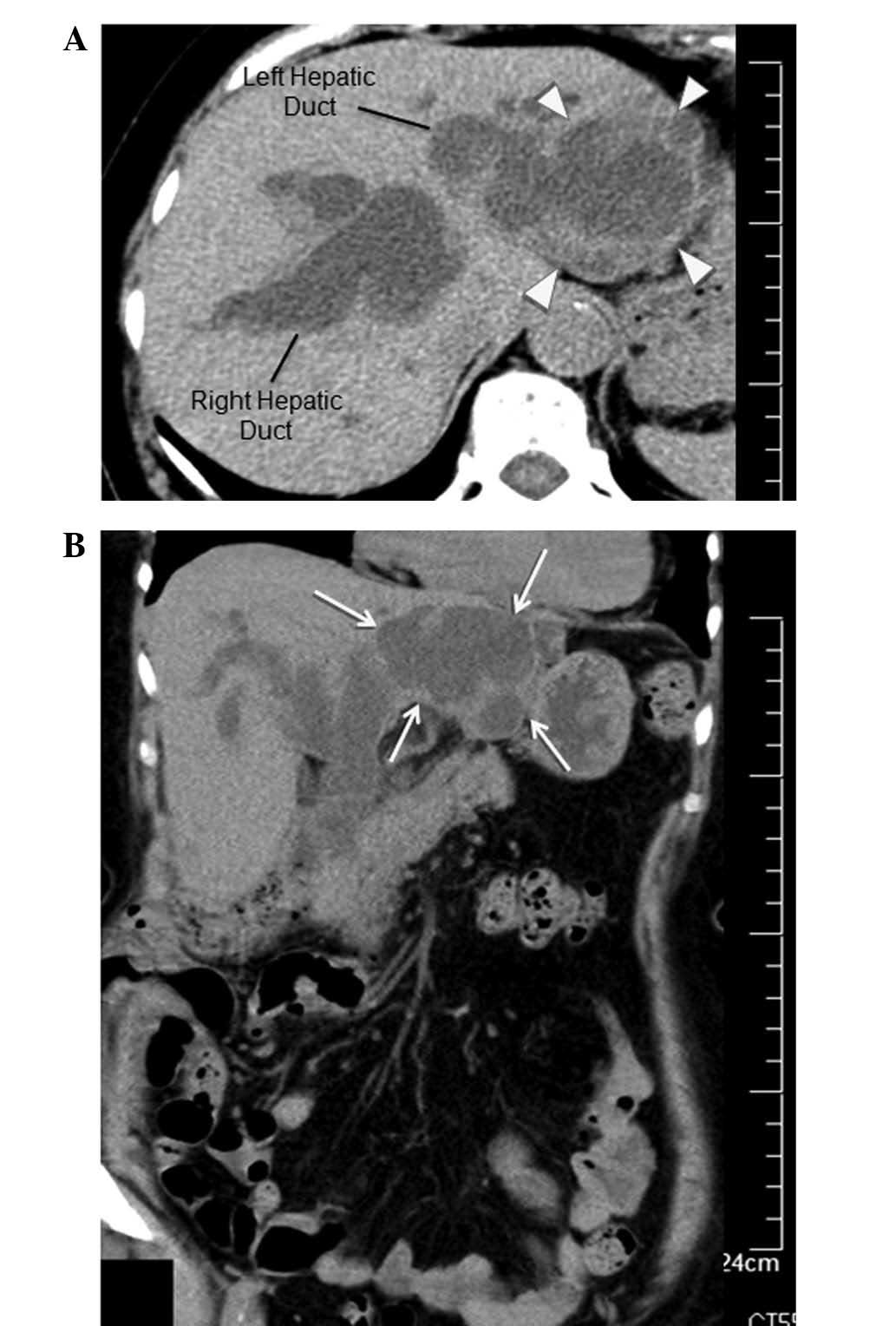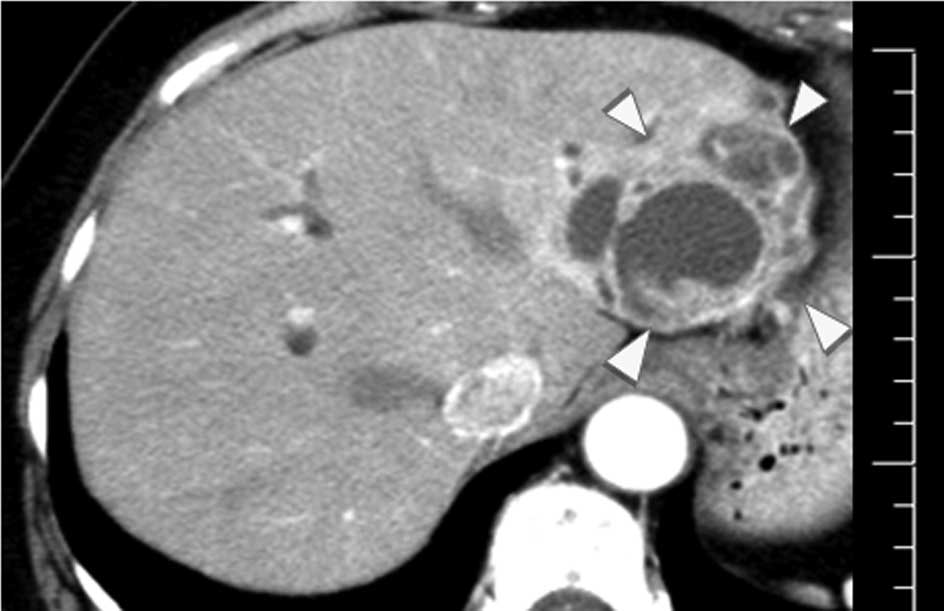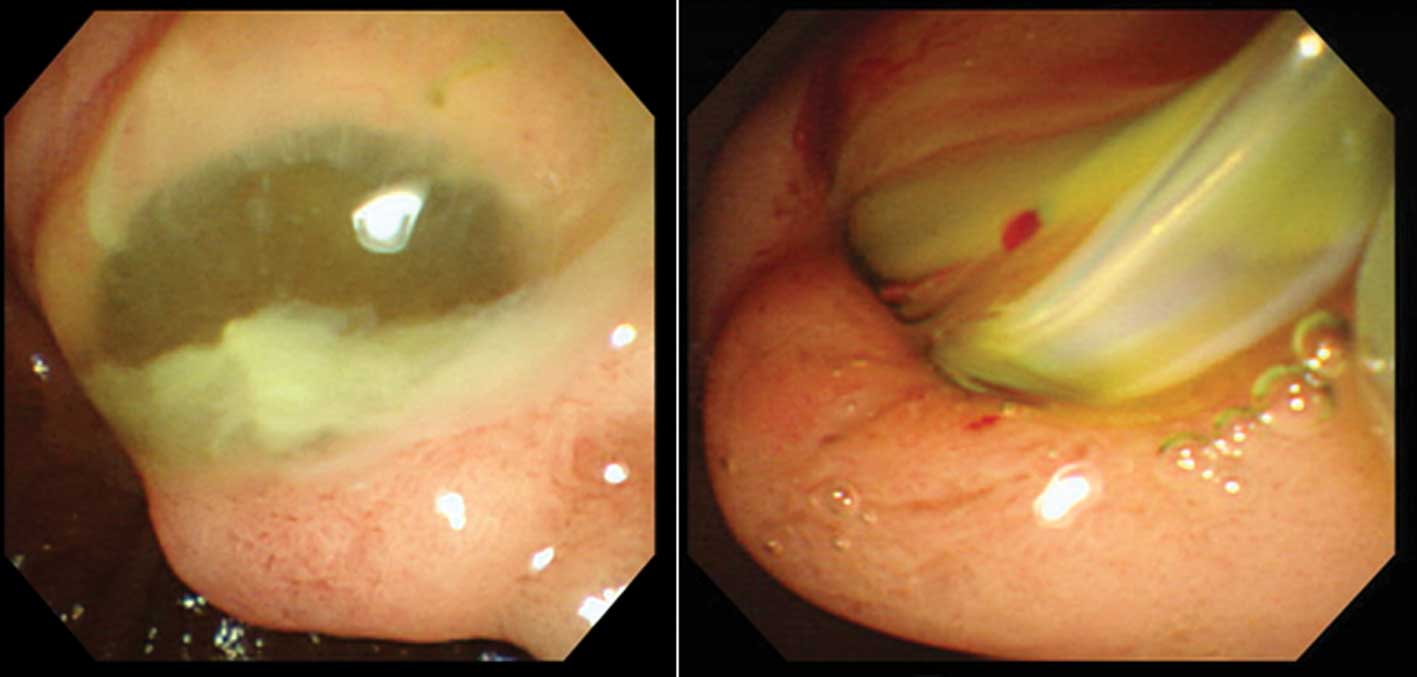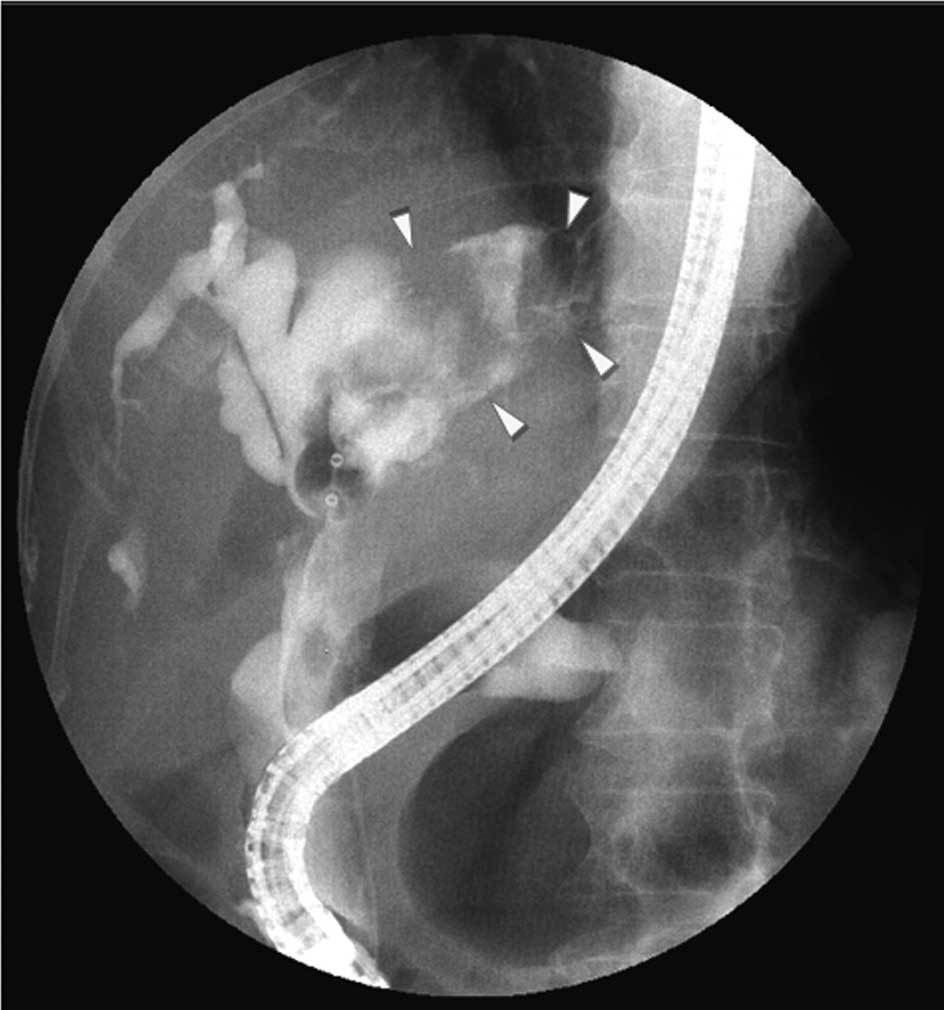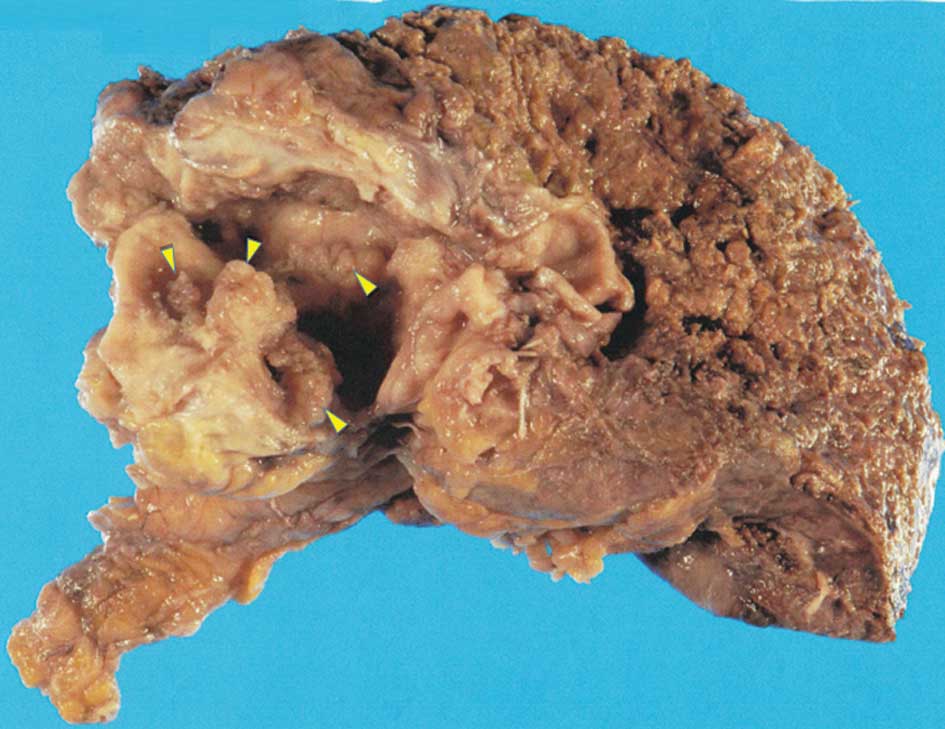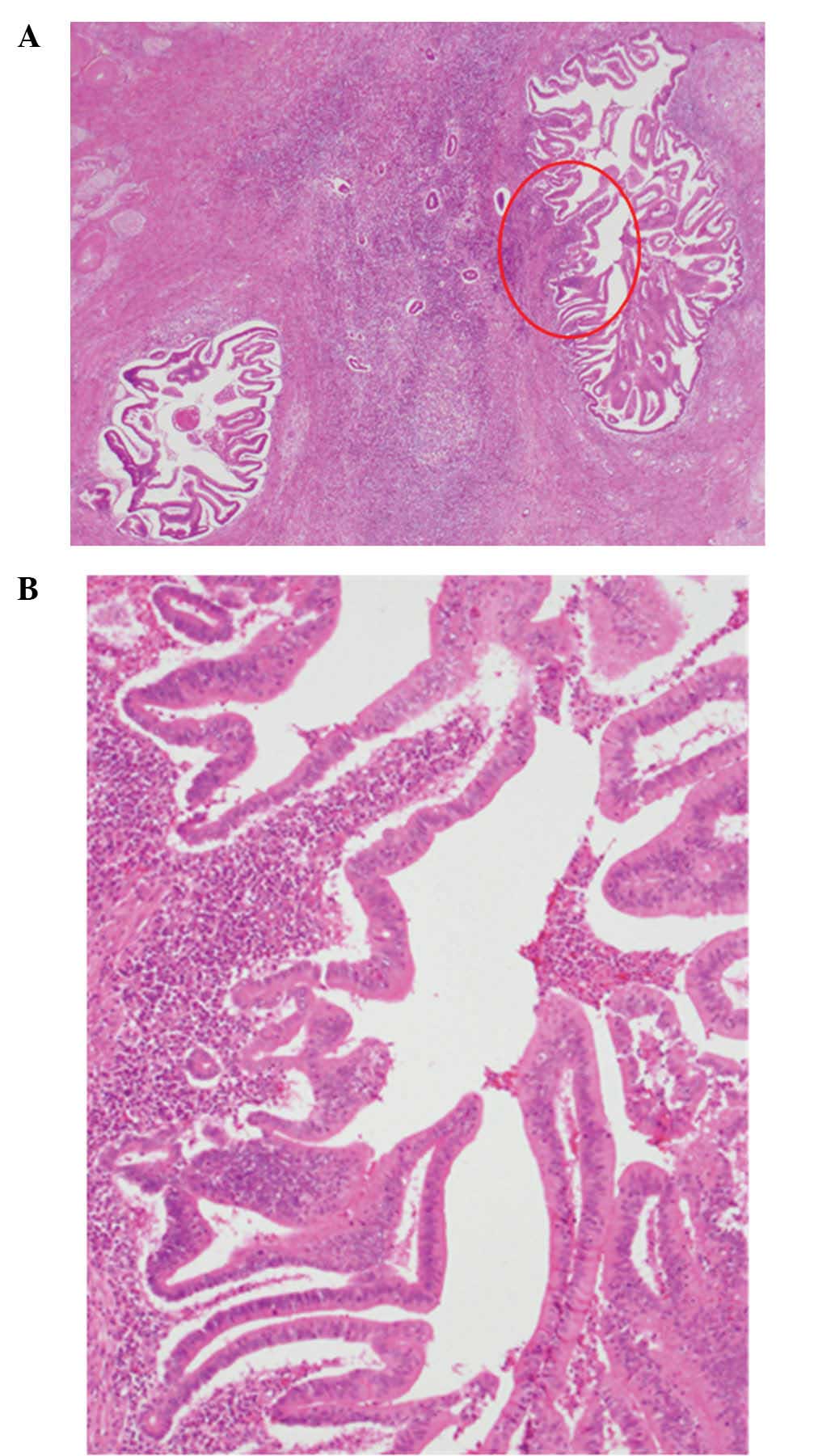A case of branch duct type intraductal papillary neoplasm of the bile duct treated by open surgery after 11 years of follow‑up
- Authors:
- Published online on: July 25, 2013 https://doi.org/10.3892/mco.2013.160
- Pages: 965-969
Abstract
Introduction
The intraductal papillary neoplasm of the bile duct (IPNB) is a novel disease concept that was recently classified as a biliary cystic tumor by the revised World Health Organization classification released in 2010 (1). Recently, an additional type of IPNB, the branch duct type, was described and relevant cases have been reported (2–5). Since IPNB is usually treated surgically at the time of diagnosis, the natural history of the tumor is largely unknown. This report describes a rare case of branch duct type IPNB, in which the patient initially declined surgery and was followed up with a tentative diagnosis of mucus-producing hepatic tumor for 11 years, after which time she finally consented to surgery, enabling a definitive diagnosis.
Case report
A 70-year-old female patient developed obstructive jaundice and cholangitis in 2000, originally attributed to a mucus-producing hepatic tumor, and was treated at a local hospital. Surgery was advised due to the repeated episodes; however, the patient refused and continued to receive medical treatment. In May, 2011, the patient developed jaundice and fever and was treated with antibiotics. The symptoms did not resolve and she was admitted to the Tokyo Rosai Hospital. The patient’s medical history included surgery for appendicitis at the age of 50 years and cholecystectomy for cholecystitis due to gallstones at the age of 62 years. There was no significant family history. In addition, the patient had developed allergic shock induced by iodinated contrast medium during the contrast-enhanced computed tomography (CT) in 2000; therefore, no iodinated contrast medium was used in 2011.
On admission, the patient exhibited a clear sensorium, with a blood pressure of 123/73 mmHg, body temperature of 37.5°C and pulse rate of 60 beats/min. The palpebral conjunctiva was not anemic, whereas the bulbar conjunctiva was colored yellow.
Breathing and heart sounds were clear. The abdomen was flat and soft, with tenderness localized to the right upper quadrant, without rebound tenderness or muscular rigidity. Blood testing on admission indicated mild anemia, with a hemoglobin level of 9.9 g/dl, predominantly direct hyperbilirubinemia and jaundice, with a total bilirubin level of 4.6 mg/dl and a direct bilirubin level of 3.8 mg/dl, and increased inflammatory reaction, with a C-reactive protein level of 14.7 mg/dl. All tumor markers were normal (Table I).
The non-contrast-enhanced CT scan performed on hospital day 1 revealed a 50-mm cystic mass with an internal septum in the left hepatic lobe and dilated intra- and extra-hepatic bile ducts (Fig. 1). The contrast-enhanced CT performed on initial presentation at another hospital in 2000, had also revealed a 50-mm cystic mass with an internal septum in the left hepatic lobe, suggesting that the mass had remained unchanged in size between 2000 and 2011. However, there was no dilation of the intra- and extra-hepatic bile ducts on the initial CT scan (Fig. 2). On hospital day 2, endoscopic retrograde cholangiopancreatography (ERCP) was performed and revealed an expanded papilla of Vater due to the presence of a mucous plug. A retrieval balloon catheter (Extractor Pro 15/18 mm, 6–7 Fr; Boston Scientific, Cork, Ireland) was inserted into the upper bile duct, inflated to fit the diameter of the bile duct and the mucous plug was removed. This procedure resulted in drainage of copious amounts of mucus and infected bile (Fig. 3). After the same procedure was repeated 3–4 times, cholangiography was performed and revealed that the cystic mass in the left lobe was communicating with the bile duct, with a clear zone in the cystic cavity that appeared to represent a large amount of mucus (Fig. 4). After informing the patient of the increased risk of recurrent cholangitis due to increased mucus production by the cystic mass in the left hepatic lobe, despite the absence of change in size over 11 years, and the potentially malignant nature of the cystic mass, the patient finally consented to surgery. Left hepatic lobectomy was performed on hospital day 34.
Macroscopically, the tumor was 50×60 mm in size, the intrahepatic segmental B3 bile duct was markedly dilated and multiple papillary projections were observed in the bile duct lumen (Fig. 5). On microscopic examination, the intrahepatic bile ducts were markedly dilated, with papillary projections in the lumen. The tumor cells exhibited marked nuclear atypia and pseudostratification and the tumor was diagnosed as a low-grade intraductal papillary neoplasm of the bile duct. No ovarian-like stroma was identified (Fig. 6).
Discussion
IPNB is defined as a bile duct epithelial tumor with papillary proliferation in the bile duct lumen and has been classified, along with biliary mucinous cystic neoplasm, under the category of biliary cystic tumors in the revised World Health Organization classification released in 2010 (1). IPNB is considered a precancerous lesion or an intraepithelial neoplasm of the biliary tract and divided, according to tumor cell grade, into intraductal papillary neoplasm with low-, intermediate- or high-grade intraepithelial neoplasia (1). The disease concept of IPNB was first proposed by Chen et al (6) and Nakanuma et al (7). IPNB is often classified into gastric, intestinal, pancreatobiliary or oncocytic subtypes, similar to intraductal papillary mucinous neoplasm (IPMN) (1). Ohtsuka et al (8) reported that the pancreatobiliary is the most common type of non-mucus-producing IPNB, whereas the intestinal type is the most common type of mucus-producing IPNB. That study also reported that the former type has a higher grade of malignancy compared to the latter type and that the degree of malignant transformation and tumor extension vary depending on the status of mucus production. Kim et al (9) also reported that mucus-producing IPNBs were more frequently encountered in patients with the gastric or intestinal subtypes compared to in those with the oncocystic or pancreatobiliar subtypes. The frequency of invasive cancer was also significantly higher in the cases with the pancreatobiliary compared to those with the gastric subtype. Accordingly, patients with pancreatobiliary IPNB exhibited significantly poorer prognosis compared to those with gastric or intestinal IPNB. The 5-year survival rate was the highest among patients with the gastric subtype (83.9%), whereas for the intestinal and pancreatobiliary subtypes it was 75.4 and 46.8%, respectively.
Imaging modalities, such as ERCP and CT, do not provide clear contrast-enhanced images of bile ducts or differentiation between clear zones representing mucus and tumors in patients with high mucus-producing IPNBs. Tsuyuguchi et al (10) reported that accurate diagnosis of the size and localization of tumors by imaging modalities, such as cholangiography, is not feasible in such cases. Thus, it is difficult to determine the exact size of IPNBs, although in the present case the tumor size, as assessed by CT, remained almost unchanged over a period of 11 years. However, the prominent dilation of intra- and extra-hepatic bile ducts, as compared to that observed on CT scans performed 11 years earlier, indicated increased mucus production by the tumor. The surgically resected tumor was histologically diagnosed as intestinal IPNB and was considered, according to Ohtsuka et al (8), to be of the high mucus-producing subtype. The tumor was histologically classified as low-grade, suggesting a relatively slow rate of disease progression.
Another possible reason for the slow progression is that the tumor was branch duct type IPNB. IPNB continues to draw attention due to its morphological and phenotypical resemblance to the main duct type of IPMN (1,6,11). The branch duct type IPMN has also been reported in the pancreas. This lesion forms at the bifurcation of the main pancreatic duct, where branched pancreatic ducts become cystically dilated and assume a botryoidal shape, exhibiting excessive mucus production (12,13). Recently, several case reports of branch duct type IPNB were reported (2–5). In all of these cases, cystic or papillary lesions were identified in the peribiliary glands. The peribiliary glands are accessory glandular tissues located around the extrahepatic and major intrahepatic bile ducts (6,14,15). These accessory glands are distributed in the connective tissue surrounding the bile ducts or in the bile duct wall and are connected to the bile duct lumen through a specific duct. A recent study indicated that various lesions may occur in the peribiliary glands (16). Lim et al (2) reviewed imaging findings of cystic IPNBs and pathological findings of resected specimens and reported that certain types of cystic IPNB, particularly those with against bile ducts, originate from the peribiliary glands and are considered as the counterpart of branch duct type IPMN. In a review of 12 cases of IPNB (2), 10 cases were carcinoma in situ and 2 cases were mucinous adenocarcinoma with partial invasion. Those findings suggested that IPNB originating from peribiliary glands may also undergo gradual transformation from adenoma to malignant tumor and eventually to invasive cancer.
Nakanishi et al (17) reported 2 cases of IPNB in which a multilocular cyst was formed in the sparse connective tissue surrounding the bile duct wall, with the cystic cavity communicating with the bile duct. The authors of that study suggested that, among the epithelial, luminal and glandular structures communicating with the bile duct, the peribiliary gland is the most likely candidate as the origin of this type of epithelial tumor. It was also suggested that the multilocular structure of the tumor may be the result of the extension of tumor cells arising from a single acinus to an adjoining acinus through a specific duct and that the cystic morphology may be due to the expansion of the inner cavity of the gland by mucus secreted from a papillary tumor arising from the peribiliary gland. The authors of that study also hypothesized that a tumor arising in a peribiliary gland extends into the epithelium through a dilated specific duct and further extends through the duct opening into the bile duct lumen, forming a papillary tumor protruding into the lumen, while continuously replacing the biliary epithelium.
In the present case, the mass included surrounding peribiliary glands and the histological images revealed no typical papillary growth in the peribiliary glands. However, imaging studies revealed a cystic mass, a characteristic finding of branch duct type IPNB, in the left hepatic lobe. Another important finding was that the size of the tumor remained almost unchanged for 11 years. If branch duct type IPNB is the counterpart of branch duct type IPMN, the progression of the lesion should occur as slowly as branch duct type IPMN. Thus, this finding also supports the diagnosis of branch duct type IPNB in the present case. Considering the limited number of available case reports on branch duct type IPNB and the fact that IPNB is usually treated surgically at the time of diagnosis, the present case, with its long-term follow-up of 11 years, provides valuable insight into the natural history of this type of tumor.
Abbreviations:
|
IPNB |
intraductal papillary neoplasm of the bile duct |
|
CT |
computed tomography |
|
ERCP |
endoscopic retrograde cholangiopancreatography |
|
IPMN |
intraductal papillary mucinous neoplasm |
References
|
Nakanuma Y, Curabo MP, Franceschi S, et al: Intrahepatic cholangiocarcinoma. WHO Classification of Tumours of the Digestive System. Bosman FT, Carnerio F, Hruban RH and Theise ND: 4th edition. IARC Press; Lyon: pp. 217–224. 2010 | |
|
Lim JH, Zen Y, Jang KT, Kim YK and Nakanuma Y: Cyst-forming intraductal papillary neoplasm of the bile ducts: description of imaging and pathologic aspects. AJR Am J Roentgenol. 197:1111–1120. 2011. View Article : Google Scholar : PubMed/NCBI | |
|
Nakanishi Y, Nakanuma Y, Ohara M, et al: Intraductal papillary neoplasm arising from peribiliary glands connecting with the inferior branch of the bile duct of the anterior segment of the liver. Pathol Int. 61:773–777. 2011. View Article : Google Scholar | |
|
Nakanishi Y, Zen Y, Hirano S, et al: Intraductal oncocytic papillary neoplasm of the bile duct: the first case of peribiliary gland origin. J Hepatobiliary Pancreat Surg. 16:869–873. 2009. View Article : Google Scholar : PubMed/NCBI | |
|
Zen Y, Amarapurkar AD and Portmann BC: Intraductal tubulopapillary neoplasm of the bile duct: potential origin from peribiliary cysts. Hum Pathol. 43:440–445. 2012. View Article : Google Scholar : PubMed/NCBI | |
|
Chen TC, Nakanuma Y, Zen Y, et al: Intraductal papillary neoplasia of the liver associated with hepatolithiasis. Hepatology. 34:651–658. 2001. View Article : Google Scholar : PubMed/NCBI | |
|
Nakanuma Y, Sasaki M, Ishikawa A, Tsui W, Chen TC and Huang SF: Biliary papillary neoplasm of the liver. Histol Histopathol. 17:851–861. 2002.PubMed/NCBI | |
|
Ohtsuka M, Kimura F, Shimizu H, et al: Similarities and differences between intraductal papillary tumors of the bile duct with and without macroscopically visible mucin secretion. Am J Surg Pathol. 35:512–521. 2011. View Article : Google Scholar | |
|
Kim KM, Lee JK, Shin JU, et al: Clinicopathologic features of intraductal papillary neoplasm of the bile duct according to histologic subtype. Am J Gastroenterol. 107:118–125. 2012. View Article : Google Scholar | |
|
Tsuyuguchi T, Sakai Y, Sugiyama H, et al: Endoscopic diagnosis of intraductal papillary mucinous neoplasm of the bile duct. J Hepatobiliary Pancreat Sci. 17:230–235. 2010. View Article : Google Scholar : PubMed/NCBI | |
|
Nakanuma Y: A novel approach to biliary tract pathology based on similarities to pancreatic counterparts: is the biliary tract an incomplete pancreas? Pathol Int. 60:419–429. 2010. View Article : Google Scholar | |
|
Adsay NV, Fukushima N, Furukawa T, et al: Intraductal neoplasms of the pancreas. WHO Classification of Tumours of the Digestive System. Bosman FT, Carnerio F, Hruban RH and Theise ND: 4th edition. IARC Press; Lyon: pp. 304–313. 2010 | |
|
Ban S, Naitoh Y, Mino-Kenudson M, et al: Intraductal papillary mucinous neoplasm (IPMN) of the pancreas: its histopathologic difference between 2 major types. Am J Surg Pathol. 30:1561–1569. 2006. View Article : Google Scholar : PubMed/NCBI | |
|
Nakanuma Y, Hoso M, Sanzen T, et al: Microstructure and development of the normal and pathologic bilary tract in humans, including blood supply. Microsc Res Tech. 38:552–570. 1997. View Article : Google Scholar : PubMed/NCBI | |
|
Nakanuma Y, Zen Y and Portman BC: Diseases of the bile ducts. MacSween’s Pathology of the Liver. Burt AD, Portman BC and Ferrell LD: 6th edition. Churchill Livingstone; Edinburg: pp. 491–562. 2011 | |
|
Cardinale V, Wang Y, Carpino G, et al: Multipotent stem/progenitor cells in human biliary tree give rise to hepatocytes, cholangiocytes and pancreatic islets. Hepatology. 54:2159–2172. 2011. View Article : Google Scholar : PubMed/NCBI | |
|
Nakanishi Y, Ohara M, Nakanuma Y, et al: Intraductal papillary neoplasm of bile duct arising from the peribiliary gland and its malignant progression. Kan Tan Sui. 65:495–502. 2012.(In Japanese). |



